


The Pancratiuskerk (St. Pancras Church) is a Roman Catholic church in Heerlen in the Netherlands.



The Pancratiuskerk (St. Pancras Church) is a Roman Catholic church in Heerlen in the Netherlands.
Although no written sources about the origin of the church are known, a comparative study (including among others Onze-Lieve-Vrouwebasiliek in Maastricht) concludes that building started in the first half of the 12th century. [1] However, since this study the age of both Onze-Lieve-Vrouwebasiliek and the church of Rolduc have been pushed back two centuries. It is suggested that the building of the Pancratiuskerk also started earlier, the 11th and possibly 10th century are most likely. [2]
It is believed that the building was commissioned by the counts of Ahr-Hochstaden in the Rhineland, then the lords of Heerlen. [1]
The current bell tower was built in 1394, and for the size of the church at that time was of a relatively heavy construction. The tower served as part of the defense mechanism for the Landsfort Herle.
From 1632 till 1836 the Pancratiuskerk served as a shared church for both Catholics and Protestants. The Protestants obtained their own church in 1836 and the arrangement ended. [3]
A stair tower, located on the south side of the bell tower was built in 1862. [4]
Between 1901 and 1903 Joseph Cuypers renovated and enlarged the church. The choir was demolished and replaced by a new eastern part, with a transept, crossing tower and a new choir, all in neo-romanesque style and using marl stone. [4]
Frits Peutz, best known for the Glaspaleis located on the same square, supervised the repair of war damage between 1945 and 1948. [4]
In 1960 a sacristy and a baptistry were built on the south side. [4]
The current interior is a mixture of an interior created by Pierre Cuypers in 1880 and a modernisation of 1969. Frescoes created by Charles Eyck decorate parts of the ceiling. [4]
The stained glass windows dating from between 1947 until the 1960s was created by Eugène Laudy and include Saint Nicholas, Saint Andrew, Saint Barbara, and Saint Servatius. [4]
The building is a triple-aisled cruciform basilica in a combination of Romanesque and Neoromanesque styles.


Heerlen is a city and a municipality in the southeast of the Netherlands. It is the third largest settlement proper in the province of Limburg. Measured as municipality, it is the fourth municipality in the province of Limburg.

The Saint-Salvator Cathedral is the cathedral of Bruges, Flanders, in present-day Belgium. The cathedral is dedicated to the Verrezen Zaligmaker and Saint-Donatius of Reims.
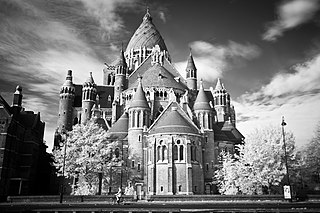
The Cathedral of Saint Bavo is a cathedral in Haarlem, the Netherlands, built by Joseph Cuypers from 1895 to 1930 to replace the former waterstaatskerk in the Jansstraat called the St. Joseph. That church was itself a replacement for the Sint-Bavokerk, that had been converted to Protestantism from Catholicism in 1578. The Cathedral of Saint Bavo now serves as the main cathedral for the Roman Catholic Diocese of Haarlem-Amsterdam. Within the Cathedral, the former sacristy has been converted into a small museum (schatkamer) containing historical artefacts from Haarlem's Catholic past.

The Cathedral of Our Lady is a Roman Catholic cathedral in Antwerp, Belgium. Today's see of the Diocese of Antwerp started in 1352 and, although the first stage of construction was ended in 1521, has never been 'completed'. In Gothic style, its architects were Jan and Pieter Appelmans. It contains a number of significant works by the Baroque painter Peter Paul Rubens, as well as paintings by artists such as Otto van Veen, Jacob de Backer and Marten de Vos.

The Tournai Cathedral, or Cathedral of Our Lady , is a Roman Catholic church, see of the Diocese of Tournai in Tournai, Belgium. It has been classified both as a Wallonia's major heritage since 1936 and as a World Heritage Site since 2000.

The Schelmentoren in Heerlen is a Medieval Building that has served as a defendable living tower for the Here van Are and their successors. As part of the Landsfort Herle, it served as a prison tower. It is believed to be built on command of Theoderich van Are. What is certain is that the building existed in the 12th century.

Jan Stuyt was a Dutch architect.
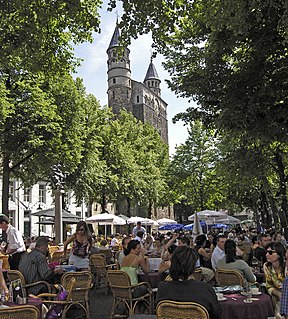
The Onze Lieve Vrouweplein is a square in the historic center of Maastricht, the Netherlands. The square is situated south of Maastricht's pedestrianised shopping district. Well known for its many café terraces, it is a popular place with tourists and local people alike.

The Catholic Cathedral of Limburg, also known as Georgsdom in German after its dedication to Saint George, is located above the old town of Limburg in Hesse, Germany. It is the cathedral of the Catholic Diocese of Limburg. Its high location on a rock above the river Lahn provides its visibility from far away. It is the result of an Early Gothic modernization of an originally Early Romanesque building and therefore shows a Romanesque-Gothic transitional style.

The Basilica of Saint Servatius is a Roman Catholic church dedicated to Saint Servatius, in the city of Maastricht, the Netherlands. The architecturally hybrid but mainly Romanesque church is situated next to the Gothic church of Saint John, backing onto the town's main square, Vrijthof.

Naumburg Cathedral, located in Naumburg, Germany, is the former cathedral of the Bishopric of Naumburg-Zeitz. The church building, most of which dates back to the 13th century, is a renowned landmark of the German late Romanesque and was recognised as a UNESCO World Heritage Site in 2018. The west choir with the famous donor portrait statues of the twelve cathedral founders (Stifterfiguren) and the Lettner, works of the Naumburg Master, is one of the most significant early Gothic monuments.
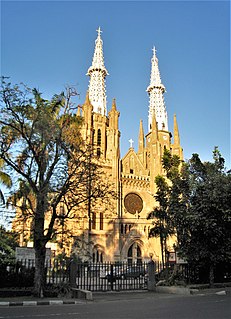
Jakarta Cathedral is a Roman Catholic cathedral in Jakarta, Indonesia, which is also the seat of the Roman Catholic Archbishop of Jakarta, currently Archbishop Ignatius Suharyo Hardjoatmodjo. Its official name is Gereja Santa Perawan Maria Diangkat ke Surga. This current cathedral was consecrated in 1901 and built in the neo-gothic style, a common architectural style to build churches at that time. The Jakarta Cathedral is located in Central Jakarta near Merdeka Square and Merdeka Palace, right in-front of the cathedral stands the Istiqlal Mosque.
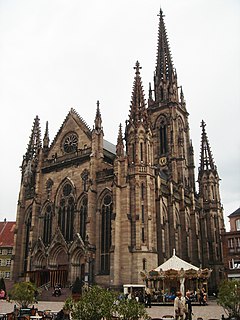
The Temple Saint-Étienne is a Calvinist church located in the city of Mulhouse, Alsace, France. Its congregation forms part of the Protestant Reformed Church of Alsace and Lorraine. Because of its central location on the main square of Mulhouse, the Place de la Réunion, and its 97 metre high bell tower, it is sometimes referred to as the "Cathedral of Mulhouse". The church was designed by the city architect Jean-Baptiste Schacre, who also designed the large Catholic St. Stephen's Church.

The Protestant church of Jistrum or Saint Peter's church is a medieval religious building in Jistrum, Friesland, Netherlands. It is a well preserved and complete 13th century Romanesque church built of red brick, located in the center of the village on Schoolstraat 2. The church is listed as a Rijksmonument, number 35645.
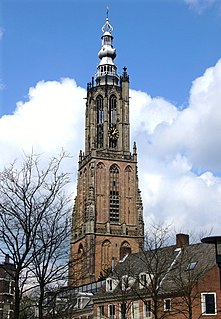
The Onze-Lieve-Vrouwetoren is a church tower in Amersfoort. The Late Gothic building is 98.33 metres tall and reaches high above the inner city. It is one of the most eye-catching monuments in town and the third highest church tower in the Netherlands. The nickname of the tower is Lange Jan. The church that belonged to the tower was destroyed by a gunpowder explosion in the 18th century.
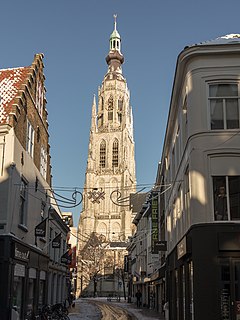
The Grote Kerk or Onze-Lieve-Vrouwekerk is the most important monument and a landmark of Breda. The church is built in the Brabantine Gothic style. The tower of the church is 97 meters tall. The plan is in the shape of a Latin Cross.

The Basilica of Our Lady is a Romanesque church in the historic center of Maastricht, Netherlands. The church is dedicated to Our Lady of the Assumption and is a Roman Catholic parish church in the Diocese of Roermond. The church is often referred to as the Star of the Sea, after the church's main devotion, Our Lady, Star of the Sea.
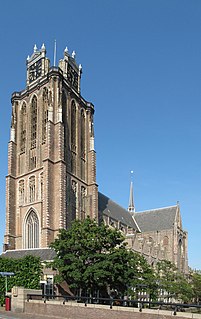
The Grote Kerk of Dordrecht, officially the Church of Our Lady is a large church in the Brabantine Gothic style, and the largest church in the city. It was built between 1284 and 1470, though some parts are newer. It became a Protestant church in 1572, and remains an active church, now owned by the Protestant Church in the Netherlands.
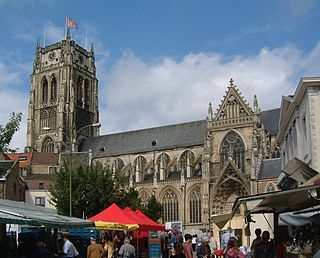
The Basilica of Our Lady also called Old Cathedral of Tongeren It is the main place of Catholic worship in the city of Tongeren, Belgium and the former cathedral of the suppressed diocese of Tongeren.

St Willibrordus is a basilica located in the center of the fortress city of Hulst in the east of Zeelandic Flanders, The Netherlands. The church is dedicated to the missionary St. Willibrord, often called the apostle of the Benelux countries. Though the nave dates from the 13th to 15th centuries, the central tower was destroyed several times, most recently in World War II. The current tower's modern appearance dates from the 1950s.